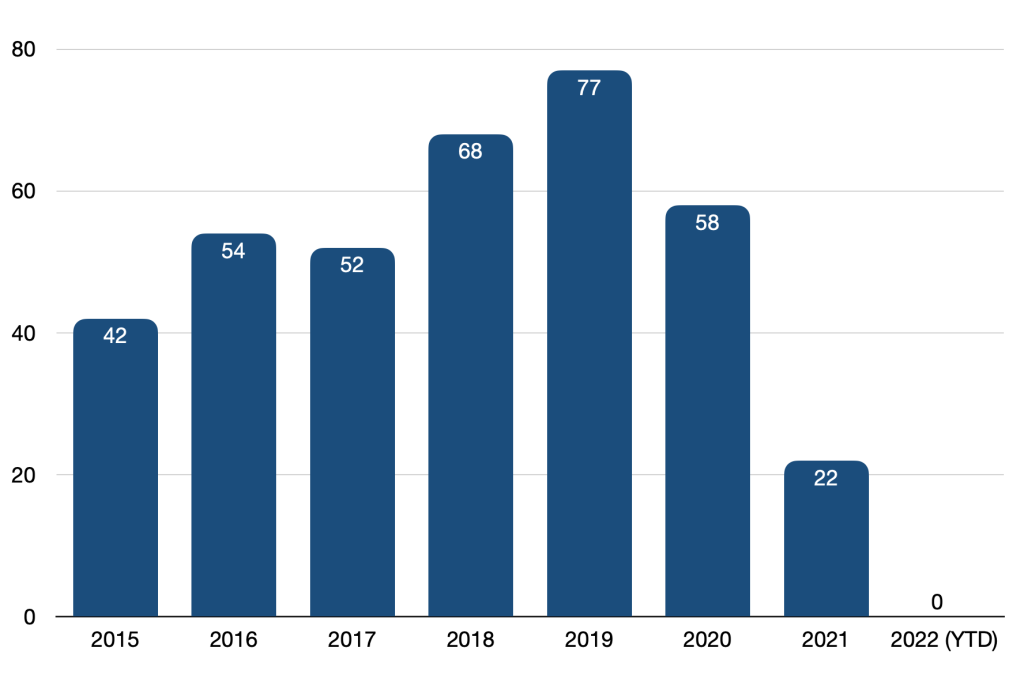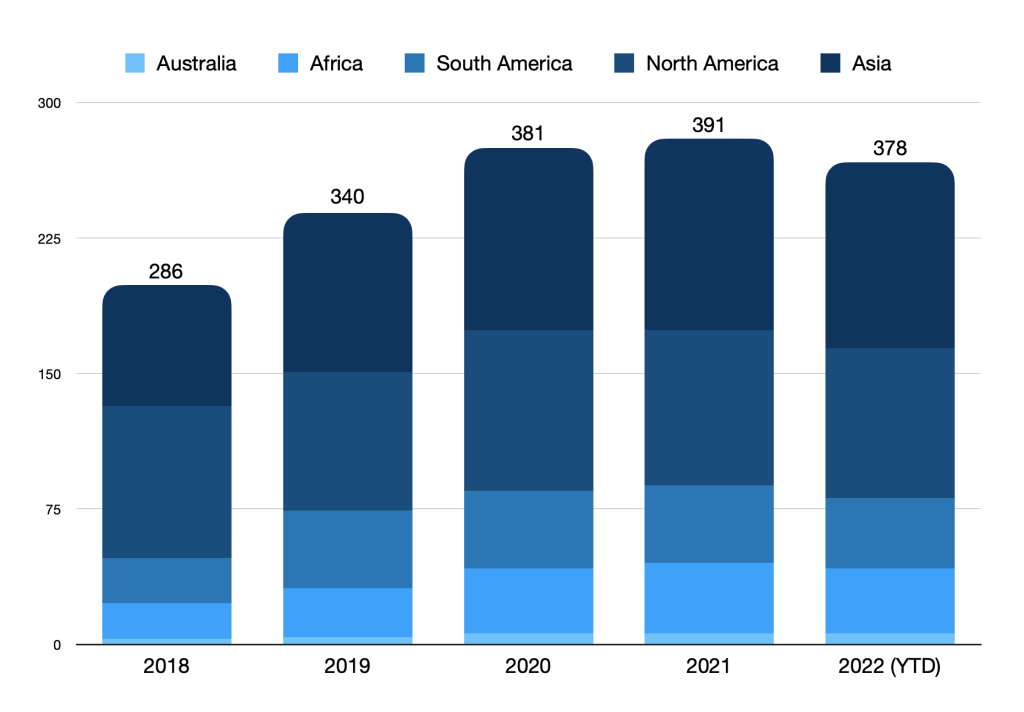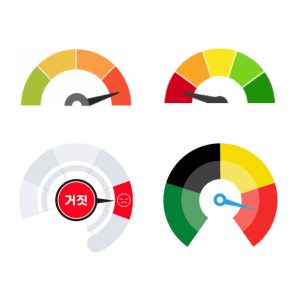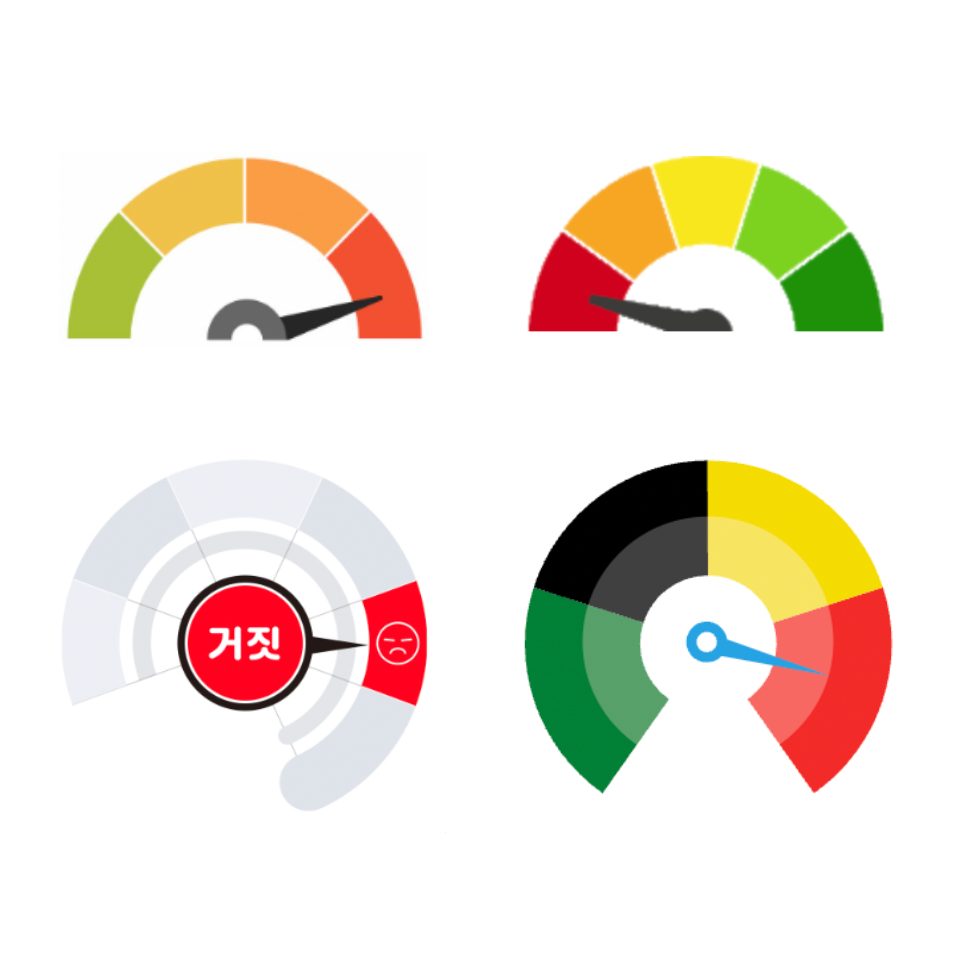When a 2019 video went viral after being edited to make House Speaker Nancy Pelosi look inebriated, it took 32 hours for one of Facebook’s independent fact-checking partners to rate the clip false. By then, the video had amassed 2.2 million views, 45,000 shares, and 23,000 comments – many of them calling her “drunk” or “a babbling mess.”
The year before, the Trump White House circulated a video that was edited to make CNN’s Jim Acosta appear to aggressively react to a mic-wielding intern during a presidential press conference.
A string of high-profile misleading videos like these in the run-up to the 2020 U.S. election stoked long-feared concerns about skillfully manipulated videos, sometimes using AI. The main worry then was how fast these doctored videos would become the next battleground in a global war against misinformation. But new research by the Duke Reporters’ Lab and a group of participating fact-checking organizations in 22 countries found that other, far less sophisticated forms of media manipulation were much more prevalent.
By using a unified tagging system called MediaReview, the Reporters’ Lab and 43 fact-checking partners collected and categorized more than 1,000 fact-checks based on manipulated media content. Those accumulated fact-checks revealed that:
- While we began this process in 2019 expecting deepfakes and other sophisticated media manipulation tactics to be the most imminent threat, we’ve predominantly seen low-budget “cheap fakes.” The vast majority of media-based misinformation is rated “Missing Context,” or, as we’ve defined it, “presenting unaltered media in an inaccurate manner.” In total, fact-checkers have applied the Missing Context rating to 56% of the MediaReview entries they’ve created.
- Most of the fact-checks in our dataset, 78%, come from content on Meta’s platforms Facebook and Instagram, likely driven by the company’s well-funded Third-Party Fact Checking-Program. These platforms are also more likely to label or remove fact-checked content. More than 80% of fact-checked posts on Instagram and Facebook are either labeled to add context or no longer on the platform. In contrast, more than 60% of fact-checked posts on YouTube and Twitter remain intact, without labeling to indicate their accuracy.
- Without reliable tools for archiving manipulated material that is removed or deleted, it is challenging for fact-checkers to track trends and bad actors. Fact-checkers used a variety of tools, such as the Internet Archive’s Wayback Machine, to attempt to capture this ephemeral misinformation; but only 67% of submitted archive links were viewable on the chosen archive when accessed at a later date, while 33% were not.
The Reporters’ Lab research also demonstrated MediaReview’s potential — especially based on the willingness and enthusiastic participation of the fact-checking community. With the right incentives for participating fact-checkers, MediaReview provides efficient new ways to help intercept manipulated media content — in large part because so many variations of the same claims appear repeatedly around the world, as the pandemic has continuously demonstrated.
The Reporters’ Lab began developing the MediaReview tagging system around the time of the Pelosi video, when Google and Facebook separately asked the Duke team to explore possible tools to fight the looming media misinformation crisis.
MediaReview is a sibling to ClaimReview, an initiative the Reporters’ Lab led starting in 2015, that sought to create infrastructure for fact-checkers to make their articles machine-readable and easily used for search engines, mobile apps, and other projects. Called “one of the most successful ‘structured journalism’ projects ever launched,” the ClaimReview schema has proven immensely valuable. Used by 177 fact-checking organizations around the world, ClaimReview has been used to tag 136,744 articles, establishing a large and valuable corpus of fact-checks: tens of thousands of statements from politicians and social media accounts around the world analyzed and rated by independent journalists.
But ClaimReview proved insufficient to address the new, specific challenges presented by misinformation spread through multimedia. Thus, in September 2019, the Duke Reporters’ Lab began working with the major search engines, social media services, fact-checkers and other interested stakeholders on an open process to develop MediaReview, a new sibling of ClaimReview that creates a standard for manipulated video and images. Throughout pre-launch testing phases, 43 fact-checking outlets have used MediaReview to tag 1,156 images and videos, again providing valuable, structured information about whether pieces of content are legitimate and how they may have been manipulated.
In an age of misinformation, MediaReview, like ClaimReview before it, offers something vital: real-time data on which pieces of media are truthful and which ones are not, as verified by the world’s fact-checking journalists.
But the work of MediaReview is not done. New fact-checkers must be brought on board in order to reflect the diversity and global reach of the fact-checking community, the major search and social media services must incentivize the creation and proper use of MediaReview, and more of those tech platforms and other researchers need to learn about, and make full use of, the opportunities this new tagging system can provide.
An Open Process
MediaReview is the product of a two-year international effort to get input from the fact-checking community and other stakeholders. It was first adapted from a guide to manipulated video published by The Washington Post, which was initially presented at a Duke Tech & Check meeting in the spring of 2019. The Reporters’ Lab worked with Facebook, Google, YouTube, Schema.org, the International Fact-Checking Network, and The Washington Post to expand this guide to include a similar taxonomy for manipulated images.
The global fact-checking community has been intimately involved in the process of developing MediaReview. Since the beginning of the process, the Reporters’ Lab has shared all working drafts with fact-checkers and has solicited feedback and comments at every step. We and our partners have also presented to the fact-checking community several times, including at the Trusted Media Summit in 2019, a fact-checkers’ community meeting in 2020, Global Fact 7 in 2020, Global Fact 8 in 2021 and several open “office hours” sessions with the sole intent of gathering feedback.
Throughout development and testing, the Reporters’ Lab held extensive technical discussions with Schema.org to properly validate the proposed structure and terminology of MediaReview, and solicited additional feedback from third-party organizations working in similar spaces, including the Partnership on AI, Witness, Meedan and Storyful.
Analysis of the First 1,156
As of February 1, 2022, fact-checkers from 43 outlets spanning 22 countries have now made 1,156 MediaReview entries.
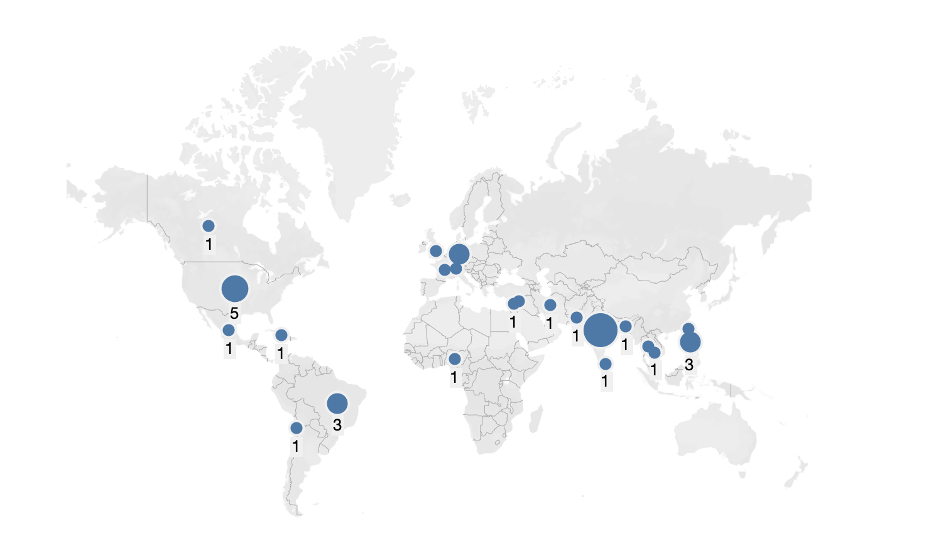
Number of outlets creating MediaReview by country.
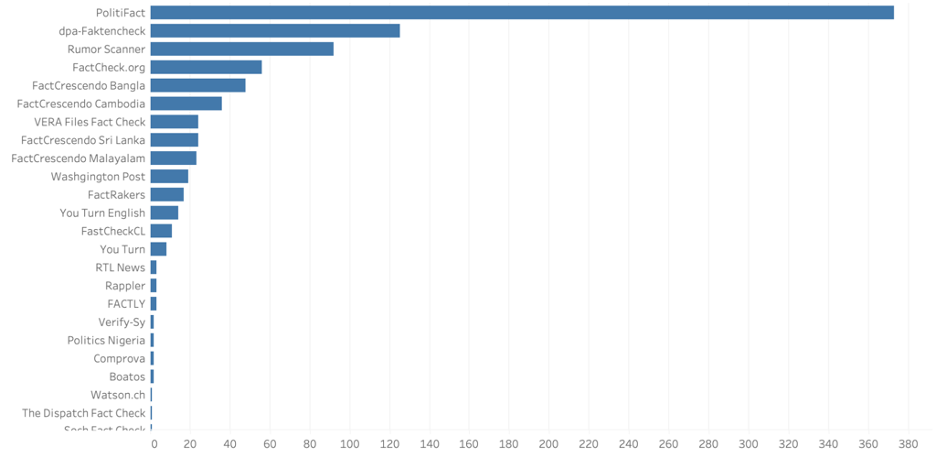
Number of MediaReview entries created by outlet.
Our biggest lesson in reviewing these entries: The way misinformation is conveyed most often through multimedia is not what we expected. We began this process in 2019 expecting deepfakes and other sophisticated media manipulation tactics to be an imminent threat, but we’ve predominantly seen low-budget “cheap fakes.” What we’ve seen consistently throughout testing is that the vast majority of media-based misinformation is rated “Missing Context,” or, as we’ve defined it, “presenting unaltered media in an inaccurate manner.” In total, fact-checkers have applied the Missing Context rating to 56% of the MediaReview entries they’ve created.
The “Original” rating has been the second most applied, accounting for 20% of the MediaReview entries created. As we’ve heard from fact-checkers through our open feedback process, a substantial portion of the media being fact-checked is not manipulated at all; rather, it consists of original videos of people making false claims. Going forward, we know we need to be clear about the use of the “Original” rating as we help more fact-checkers get started with MediaReview, and we need to continue to emphasize the use of ClaimReview to counter the false claims contained in these kinds of videos.
Throughout the testing process, the Duke Reporters’ Lab has monitored incoming MediaReview entries and provided feedback to fact-checkers where applicable. We’ve heard from fact-checkers that that feedback was valuable and helped clarify the rating system.
Reviewing media links that have been checked by third-party fact-checkers, a vast majority of fact-checked media thus far exists on Facebook:
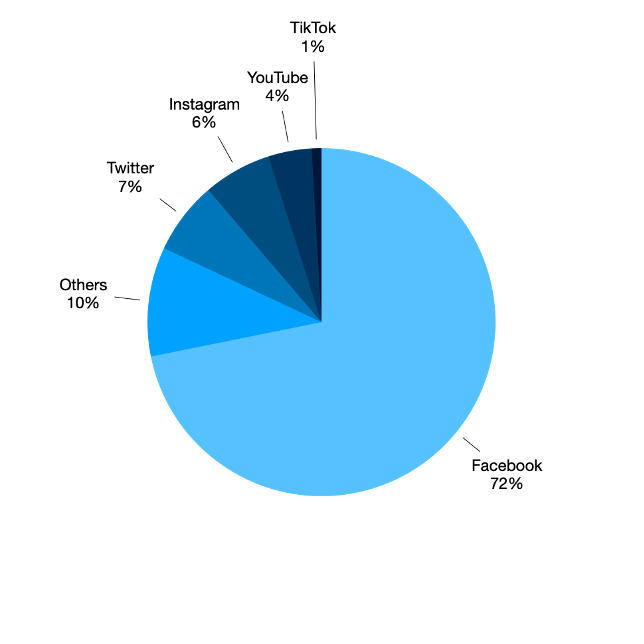
Share of links in the MediaReview dataset by platform.
Facebook’s well-funded Third Party Fact-Checking Program likely contributes to this rate; fact-checkers are paid directly to check content on Facebook’s platforms, making that content more prevalent in our dataset.
We also reviewed the current status of links checked by fact-checkers and tagged with MediaReview. With different platforms having different policies on how they deal with misinformation, some of the original posts are intact, others have been removed by either the platform or the user, and some have a context label appended with additional fact-check information. By platform, Instagram is the most likely to append additional information, while YouTube is the most likely to present fact-checked content in its original, intact form, not annotated with any fact-checking information: 72.5% of the media checked from YouTube are still available in their original format on the platform.
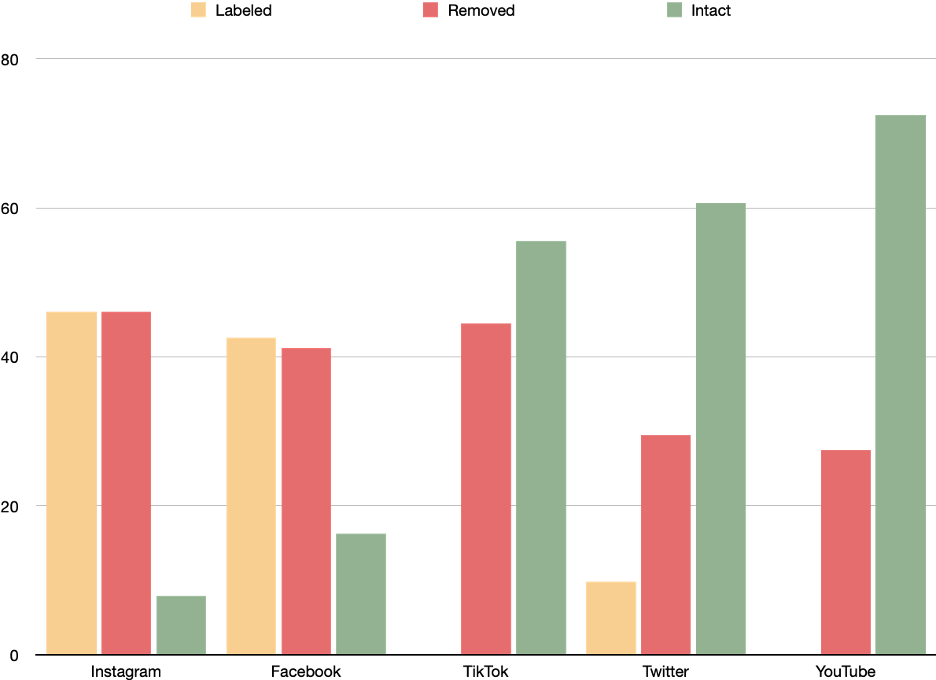
Status of fact-checked media broken down by platform, showing the percentage of checked media either labeled with additional context, removed, or presented fully intact.
In addition, we noted that fact-checkers have often (roughly 25% of the time) input an archival link into the “Media URL” field, in an attempt to capture the link for the video or image, ephemeral misinformation that is often quickly deleted by either the platforms or the users. Notably, though, these existing archive systems are unreliable; only 67% of submitted archive links were viewable on the archive, while 33% were not. While we found that Perma.cc was the most reliable existing archiving system used by fact-checkers, it only successfully presented 80% of checked media, and its status as a paid archival tool leaves an opportunity to build a new system to preserve fact-checked media.
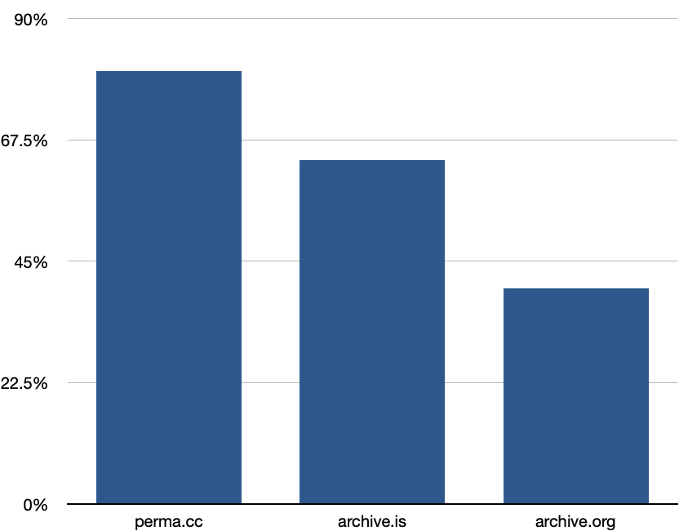
Success rate of archival tools used by fact-checkers in properly displaying the fact-checked media.
Next Steps
Putting MediaReview to use: Fact-checkers have emphasized to us the need for social media companies and search engines platforms to make use of these new signals. They’ve highlighted that usability testing would help ensure that MediaReview data was seen prominently on the tech platforms.
Archiving the images and videos: As noted above, current archiving systems are insufficient to capture the media misinformation fact-checkers are reporting on. Currently, fact-checkers using MediaReview are limited to quoting or describing the video or image they checked and including the URL where they discovered it. There’s no easy, consistent workflow for preserving the content itself. Manipulated images and videos are often removed by social media platforms or deleted or altered by their owners, leaving no record of how they were manipulated or presented out of context. In addition, if the same video or image emerges again in the future, it can be difficult to determine if it has been previously fact-checked. A repository of this content — which could be saved automatically as part of each MediaReview submission — would allow for accessibility and long-term durability for archiving, research, and more rapid detection of misleading images and video.
Making more: We continue to believe that fact-checkers need incentives to continue making this data. The more fact-checkers use these schemas, the more we increase our understanding of the patterns and spread of misinformation around the world — and the ability to intercept inaccurate and sometimes dangerous content. The effort required to produce ClaimReview or MediaReview is relatively low, but adds up cumulatively — especially for smaller teams with limited technological resources.
While fact-checkers created the first 1,156 entries solely to help the community refine and test the schema, further use by the fact-checkers must be encouraged by the tech platforms’ willingness to adopt and utilize the data. Currently, 31% of the links in our MediaReview dataset are still fully intact where they were first posted; they have not been removed or had any additional context added. Fact-checkers have displayed their eagerness to research manipulated media, publish detailed articles assessing their veracity, and make their assessments available to the platforms to help curb the tide of misinformation. Search engines and social media companies must now decide to use and display these signals.
Appendix: MediaReview Development Timeline
MediaReview is the product of a two-year international effort involving the Duke Reporters’ Lab, the fact-checking community, the tech platforms and other stakeholders.
Mar 28, 2019
Phoebe Connelly and Nadine Ajaka of The Washington Post first presented their idea for a taxonomy classifying manipulated video at a Duke Tech & Check meeting.
Sep 17, 2019
The Reporters’ Lab met with Facebook, Google, YouTube, Schema.org, the International Fact-Checking Network, and The Washington Post in New York to plan to expand this guide to include a similar taxonomy for manipulated images.
Oct 17, 2019
The Reporters’ Lab emailed a first draft of the new taxonomy to all signatories of the IFCN’s Code of Principles and asked for comments.
Nov 26, 2019
After incorporating suggestions from the first draft document and generating a proposal for Schema.org, we began to test MediaReview for a selection of fact-checks of images and videos. Our internal testing helped refine the draft of the Schema proposal, and we shared an updated version with IFCN signatories on November 26.
Jan 30, 2020
The Duke Reporters’ Lab, IFCN and Google hosted a Fact-Checkers Community Meeting at the offices of The Washington Post. Forty-six people, representing 21 fact-checking outlets and 15 countries, attended. We presented slides about MediaReview, asked fact-checkers to test the creation process on their own, and again asked for feedback from those in attendance.
Apr 16, 2020
The Reporters’ Lab began a testing process with three of the most prominent fact-checkers in the United States: FactCheck.org, PolitiFact, and The Washington Post. We have publicly shared their test MediaReview entries, now totaling 421, throughout the testing process.
Jun 1, 2020
We wrote and circulated a document summarizing the remaining development issues with MediaReview, including new issues we had discovered through our first phase of testing. We also proposed new Media Types for “image macro” and “audio,” and new associated ratings, and circulated those in a document as well. We published links to both of these documents on the Reporters’ Lab site (We want your feedback on the MediaReview tagging system) and published a short explainer detailing the basics of MediaReview (What is MediaReview?)
Jun 23, 2020
We again presented on MediaReview at Global Fact 7 in June 2020, detailing our efforts so far and again asking for feedback on our new proposed media types and ratings and our Feedback and Discussion document. The YouTube video of that session has been viewed over 500 times, by fact-checkers around the globe, and dozens participated in the live chat.
Apr 1, 2021
We hosted another session on MediaReview for IFCN signatories on April 1, 2021, again seeking feedback and updating fact-checkers on our plans to further test the Schema proposal.
Jun 3, 2021
In June 2021, the Reporters’ Lab worked with Google to add MediaReview fields to the Fact Check Markup Tool and expand testing to a global userbase. We regularly monitored MediaReview and maintained regular communication with fact-checkers who were testing the new schema.
Nov 10, 2021
We held an open feedback session with fact-checkers on November 10, 2021, providing the community another chance to refine the schema. Overall, fact-checkers have told us that they’re pleased with the process of creating MediaReview and that its similarity to ClaimReview makes it easy to use. As of February 1, 2022, fact-checkers have made a total of 1,156 MediaReview entries.
For more information about MediaReview, contact Joel Luther.
